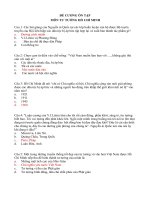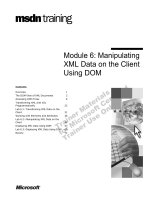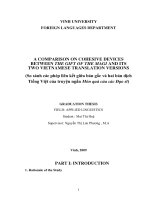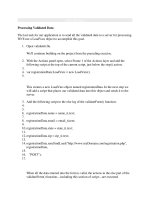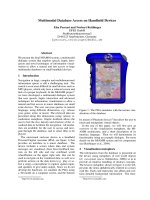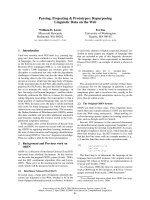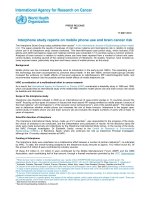Processing linked data on mobile devices (tt)
Bạn đang xem bản rút gọn của tài liệu. Xem và tải ngay bản đầy đủ của tài liệu tại đây (86.81 KB, 10 trang )
Processing Linked Data on
Mobile Devices
Tuan Anh, Le
Submitted in fulfillment of the requirements
for the degree of Master of Science
SUPERVISOR
Prof. Manfred Hauswirth
Dr. Danh Le Phuoc
Digital Enterprise Research Institute, National University of Ireland, Galway
January 2015
i
ii
“If you optimize everything you will always be unhappy.”
Donald Knuth
iii
Abstract
The Semantic Web has been evolving and becoming the preferred choice for representing information not only on the Web but also on mobile systems. Applying Linked Data technologies
on mobile systems could enable a wide range of novel mobile applications. Furthermore, the
computational, storage and network capabilities of mobile devices are constantly improving,
thereby raising interest in moving Linked Data processing closer to mobile applications.
Using RDF triplestores for storing and processing Linked Data locally on mobile devices could
reduce data transmission costs, lowering the risks of intermittent connectivity and increasing the
security of personal data. Due to these advantages, there are several works that port existing
tools for processing Linked Data from workstations to mobile devices. However, whereas the
systems for workstations are designed for using GBs of main memory and efficiently storing data
on magnetic disks, mobile devices have limited memory and are equipped with flash disks. The
differences in computing environments and storage mediums lead to performance and scalability
issues in existing mobile RDF triplestores. Therefore, algorithms and techniques for RDF
triplestores need to be carefully re-engineered to create an efficient RDF triplestore specifically
for mobile devices.
In this work, we first conduct an empirical evaluation of existing mobile RDF triplestores to
identify their performance and storage shortcomings. These findings serve as input for a novel
design of an RDF triple store tailor-made for mobile devices. We then implement this design
on the Android platform as a faster and more scalable version of RDF on the Go. Finally, we
evaluate the performance and scalability of RDF on the Go to demonstrate the advantages of
our design.
Acknowledgements
First and foremost, I would like to thank my mentor Dr. Danh Le Phuoc for his guidance and
valuable support throughout the preparation of this work and in particular for his input and
feedback on the formal model. I also would like to thank my supervisor Prof. Manfred Hauswirth
for his helpful and constructive contributions during the GRC meetings that have helped a lot
in directing the research efforts of this work. Despite his positions as both vice director of DERI
and group leader, he always had an open ear for my matters.
Special thanks are due to my colleagues Dr. Gregor Schiele and Dr. Martin Serrano with whom
I co-authored two papers. Moreover, I want to express my gratitude to Aidan Hogan and Hung
Ngo Quoc, my friends in DERI who have spent their valuable time helping me correct my
writing.
Above all, I wish to express my sincere gratitude to my beloved family for all their kind support
and the sacrifices made throughout this work.
v
Contents
Abstract
iv
Acknowledgements
v
Contents
vi
List of Figures
viii
List of Tables
1 Introduction
1.1 Motivation . . . . .
1.2 Problem Statement .
1.3 Thesis Contributions
1.4 Thesis Outline . . .
ix
.
.
.
.
.
.
.
.
.
.
.
.
.
.
.
.
.
.
.
.
.
.
.
.
.
.
.
.
.
.
.
.
.
.
.
.
.
.
.
.
.
.
.
.
.
.
.
.
.
.
.
.
.
.
.
.
.
.
.
.
.
.
.
.
.
.
.
.
.
.
.
.
.
.
.
.
.
.
.
.
.
.
.
.
.
.
.
.
.
.
.
.
1
1
3
5
6
2 Background
2.1 Resource Description Framework . . . . .
2.2 Physical Storage of RDF data . . . . . . .
2.3 Mobile Database . . . . . . . . . . . . . .
2.3.1 Mobile Applications . . . . . . . .
2.3.2 Requirements of Mobile Databases
2.4 Flash Memory . . . . . . . . . . . . . . .
2.5 Mobile Semantic Web Frameworks . . . .
2.5.1 Mobile RDF Frameworks . . . . .
2.5.2 Query and Persistence Frameworks
.
.
.
.
.
.
.
.
.
.
.
.
.
.
.
.
.
.
.
.
.
.
.
.
.
.
.
.
.
.
.
.
.
.
.
.
.
.
.
.
.
.
.
.
.
.
.
.
.
.
.
.
.
.
.
.
.
.
.
.
.
.
.
.
.
.
.
.
.
.
.
.
.
.
.
.
.
.
.
.
.
.
.
.
.
.
.
.
.
.
.
.
.
.
.
.
.
.
.
.
.
.
.
.
.
.
.
.
.
.
.
.
.
.
.
.
.
.
.
.
.
.
.
.
.
.
.
.
.
.
.
.
.
.
.
.
.
.
.
.
.
.
.
.
.
.
.
.
.
.
.
.
.
.
.
.
.
.
.
.
.
.
.
.
.
.
.
.
.
.
.
.
.
.
.
.
.
.
.
.
.
.
.
.
.
.
.
.
.
.
.
.
.
.
.
.
.
.
7
7
10
11
12
13
14
16
16
17
3 Empirical Evaluation and Experiment Analysis
3.1 Evaluation Design . . . . . . . . . . . . . . . . .
3.2 Evaluation Results . . . . . . . . . . . . . . . . .
3.3 Analysis of Evaluation Results . . . . . . . . . .
3.4 Conclusion . . . . . . . . . . . . . . . . . . . . .
.
.
.
.
.
.
.
.
.
.
.
.
.
.
.
.
.
.
.
.
.
.
.
.
.
.
.
.
.
.
.
.
.
.
.
.
.
.
.
.
.
.
.
.
.
.
.
.
.
.
.
.
.
.
.
.
.
.
.
.
.
.
.
.
.
.
.
.
.
.
.
.
18
18
21
24
26
.
.
.
.
.
27
27
31
33
33
34
4 An
4.1
4.2
4.3
.
.
.
.
.
.
.
.
.
.
.
.
.
.
.
.
.
.
.
.
.
.
.
.
Architecture of Mobile RDF
Architecture Overview . . . . .
Dictionary . . . . . . . . . . . .
Physical Storage . . . . . . . .
4.3.1 Access Pattern . . . . .
4.3.2 Sorted list . . . . . . . .
.
.
.
.
.
.
.
.
.
.
.
.
.
.
.
.
.
.
.
.
Triplestore
. . . . . . . .
. . . . . . . .
. . . . . . . .
. . . . . . . .
. . . . . . . .
vi
.
.
.
.
.
.
.
.
.
.
.
.
.
.
.
.
.
.
.
.
.
.
.
.
.
.
.
.
.
.
.
.
.
.
.
.
.
.
.
.
.
.
.
.
.
.
.
.
.
.
.
.
.
.
.
.
.
.
.
.
.
.
.
.
.
.
.
.
.
.
.
.
.
.
.
.
.
.
.
.
.
.
.
.
.
.
.
.
.
.
.
.
.
.
.
vii
Contents
4.4
4.3.3 Two-layer Index . . . . . . . . . . . . . . . . . . . . . . . . . . . . . . . .
Summary . . . . . . . . . . . . . . . . . . . . . . . . . . . . . . . . . . . . . . . .
5 RDF On The Go - mobile RDF triplestore
5.1 Performance Evaluation . . . . . . . . . . .
5.1.1 Experimental Setup . . . . . . . . .
5.1.2 Evaluation Results . . . . . . . . . .
5.2 Scalability Evaluation . . . . . . . . . . . .
5.2.1 Experiment Setup . . . . . . . . . .
5.2.2 Evaluation Results . . . . . . . . . .
.
.
.
.
.
.
.
.
.
.
.
.
.
.
.
.
.
.
.
.
.
.
.
.
.
.
.
.
.
.
.
.
.
.
.
.
.
.
.
.
.
.
.
.
.
.
.
.
.
.
.
.
.
.
.
.
.
.
.
.
.
.
.
.
.
.
.
.
.
.
.
.
.
.
.
.
.
.
.
.
.
.
.
.
.
.
.
.
.
.
.
.
.
.
.
.
.
.
.
.
.
.
.
.
.
.
.
.
.
.
.
.
.
.
.
.
.
.
.
.
.
.
.
.
.
.
35
36
38
38
39
39
43
43
45
6 Conclusions and Future Researches
48
6.1 Conclusion . . . . . . . . . . . . . . . . . . . . . . . . . . . . . . . . . . . . . . . 48
6.2 Future research . . . . . . . . . . . . . . . . . . . . . . . . . . . . . . . . . . . . . 48
A Performance of Berkeley DB & SQLLite
50
A.1 Comparison of write performance . . . . . . . . . . . . . . . . . . . . . . . . . . . 51
A.2 Comparison of read performance . . . . . . . . . . . . . . . . . . . . . . . . . . . 51
B Evaluation queries
52
Bibliography
58
List of Figures
2.1
2.2
2.3
2.4
2.5
Triple concept . . . . . .
RDF triple . . . . . . .
RDF Graph . . . . . . .
SPARQL Query . . . . .
SPARQL Triple Pattern
.
.
.
.
.
.
.
.
.
.
.
.
.
.
.
.
.
.
.
.
.
.
.
.
.
.
.
.
.
.
.
.
.
.
.
.
.
.
.
.
.
.
.
.
.
.
.
.
.
.
.
.
.
.
.
.
.
.
.
.
.
.
.
.
.
.
.
.
.
.
.
.
.
.
.
.
.
.
.
.
.
.
.
.
.
.
.
.
.
.
.
.
.
.
.
.
.
.
.
.
8
8
9
9
9
3.1
3.2
3.3
3.4
3.5
Testing application design of Android RDF store . . .
Updating throughput of OTG-BDB & TDBoid. . . . .
Memory usage of OTG-BDB & TDBoid . . . . . . . .
Query response time (OTG-BDB & TDBoid) . . . . .
Inserting throughput and memory usage of OTG-BDB
.
.
.
.
.
.
.
.
.
.
.
.
.
.
.
.
.
.
.
.
.
.
.
.
.
.
.
.
.
.
.
.
.
.
.
.
.
.
.
.
.
.
.
.
.
.
.
.
.
.
.
.
.
.
.
.
.
.
.
.
.
.
.
.
.
.
.
.
.
.
.
.
.
.
.
19
21
22
23
25
4.1
4.2
4.3
4.4
4.5
System architecture overview
Node Store . . . . . . . . . .
Triple lists . . . . . . . . . . .
Index table . . . . . . . . . .
Spare Index on Triple Table .
.
.
.
.
.
.
.
.
.
.
.
.
.
.
.
.
.
.
.
.
.
.
.
.
.
.
.
.
.
.
.
.
.
.
.
.
.
.
.
.
.
.
.
.
.
.
.
.
.
.
.
.
.
.
.
.
.
.
.
.
.
.
.
.
.
.
.
.
.
.
.
.
.
.
.
28
31
33
35
36
5.1
5.2
5.3
5.4
5.5
The update throughput of RDF-OTG, OTG-BDB and TDBoid
Memory usage of RDF-OTG, RDF-BDB and TDBoiD . . . . .
Inserting throughput and memory usage of RDF-OTG . . . . .
Query response time of RDF-OTG, TDBoiD and RDF-BDB .
Scalability of RDF-OTG . . . . . . . . . . . . . . . . . . . . . .
.
.
.
.
.
.
.
.
.
.
.
.
.
.
.
.
.
.
.
.
.
.
.
.
.
.
.
.
.
.
.
.
.
.
.
.
.
.
.
.
.
.
.
.
.
.
.
.
.
.
40
41
42
42
45
A.1 Writing speed of SQLLite and Bekelery DB . . . . . . . . . . . . . . . . . . . . .
A.2 Read speed of SQLLite and Bekelery DB . . . . . . . . . . . . . . . . . . . . . .
51
51
.
.
.
.
.
.
.
.
.
.
.
.
.
.
.
.
.
.
.
.
.
.
.
.
.
.
.
.
.
.
.
.
.
.
.
.
.
.
.
.
.
.
.
.
.
.
.
.
.
.
.
.
.
.
.
viii
.
.
.
.
.
.
.
.
.
.
.
.
.
.
.
.
.
.
.
.
.
.
.
.
.
.
.
.
.
.
.
.
.
.
.
.
.
.
.
.
.
.
.
.
.
.
.
.
.
.
.
.
.
.
.
.
.
.
.
.
.
.
.
.
.
.
.
.
.
.
.
.
.
.
.
List of Tables
4.1
Possible query patterns and corresponding indexes . . . . . . . . . . . . . . . . .
34
5.1
5.2
5.3
5.4
5.5
5.6
5.7
Memory consumption of mix queries/size of data . . . .
Android devices . . . . . . . . . . . . . . . . . . . . . . .
Memory consumption of queries mix/size of data . . . .
Query response time (seconds) on HTC Desire . . . . .
Query response time (seconds) on Galaxy Nexus . . . .
Query response time (seconds) on Nexus 7 tablet . . . .
Memory consumption query mix on different size of data
.
.
.
.
.
.
.
43
44
44
46
46
47
47
B.1 Parameters of SPARQL queries . . . . . . . . . . . . . . . . . . . . . . . . . . . .
57
ix
.
.
.
.
.
.
.
.
.
.
.
.
.
.
.
.
.
.
.
.
.
.
.
.
.
.
.
.
.
.
.
.
.
.
.
.
.
.
.
.
.
.
.
.
.
.
.
.
.
.
.
.
.
.
.
.
.
.
.
.
.
.
.
.
.
.
.
.
.
.
.
.
.
.
.
.
.
.
.
.
.
.
.
.
.
.
.
.
.
.
.

